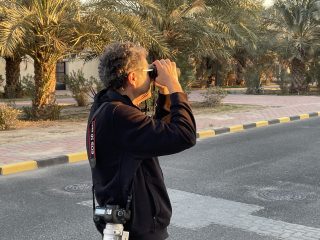Among the Gulf countries, Kuwait is one of the northernmost, and despite its small land area, it has the most valuable currency. Dr. Endre Sós and Dr. János Gál visited the country for a brief data collection mission on its bird fauna.
Entering and exiting the country is not a simple process. At the airport, biometric data collection is mandatory before entry is theoretically allowed. This includes scanning all ten fingerprints, iris recognition, and capturing facial images from two angles. In our case, after fingerprint scanning, we were permitted entry, but only after a waiting time of over an hour. However, this process caused complications upon exit. We were not allowed to leave the country until the missing biometric data had been recorded. The iris scanning process, which was not particularly fast, required nearly an hour and a half of waiting in line. This was followed by passport control and security screening. Surprisingly, even after passing through security at the airport, there was another, much stricter security check immediately before boarding the plane. We strongly recommend allowing plenty of time for the departure process at the airport.
Once we entered Kuwait, everything became smoother, though it came at a cost. The nighttime arrival offered a breathtaking view, though daylight slightly altered the impression (pictures 1–2). Unfortunately, waste management is not the country’s strongest part. However, the people are friendly, and based on our experience, public safety is good. In the morning, our expert birdwatching colleague arrived, a Kuwaiti citizen with excellent local knowledge, who guided us to the best habitats for bird observation. Despite language barriers, our shared passion for ornithology quickly eased any initial uncertainties. During our visit, we explored multiple habitats, where we observed both local bird species and wintering visitors.

1. Night view of the Persian Gulf

2. Day view of the Persian Gulf
Our first stop was the vast green park of the university of Kuwait, where we recorded the observable bird species. Our guide—an academic by profession—mentioned that Kuwait does not have a veterinary training program. In the park, we spotted a small mixed-gender group of Hypocolius (Hypocolius ampelinus) (picture 3), a wintering visitor that also breeds in the country and eats palm fruit in winter. This species is closely related to the Bohemian waxwing (Bombycilla garrulus), which occasionally appears in large numbers in our university park during invasion years.

3. Hypocolius (Photo: Dr. Endre Sós)
Throughout the day, we visited several sites further from urbanization, including the “Jahra Pool Reserve” and the “Al Liyah Reserve,” which require special permits for access. Thanks to our guide, we had the privilege to visit these areas. Jahra Pool Reserve features wetlands (picture 4), where we observed common species alongside northern shovelers (Anas clypeata), various shorebirds, black eagle (Aquila clanga), kingfisher belonging to the local fauna (Halcyon smyrnensis), and greater flamingos (Phoenicopterus roseus) in the brackish waters. In Al Liyah Reserve, we recorded multiple desert lark species and noted an interesting habitat development project. The site featured an artificial watering station and structures designed to support nesting birds.

4. A larger water surface
At a rocky habitat on the outskirts of the city (picture 5), we observed several species of wheatears, including the crowned wheatear (Oenanthe leucopyga) (picture 6). Returning to Kuwait City (Figure 7), we encountered more common regional species, including spotted doves (Streptopelia senegalensis), which were present almost everywhere.

5. Rocky habitat

6. Crowned wheatear (Oenanthe leucopyga) Photo: Dr. Endre Sós

7. Green oasis in the Kuwait University park – Dr. Endre Sós searching for Hypocolius
By the end of our birdwatching expedition, we had compiled a list of over 40 species and gained many valuable insights into Kuwait. At Jahra Pool Reserve, we recorded the Ménétries’s warbler (Sylvia mystacea), while in Al Liyah Reserve, we observed the Asian desert warbler (Sylvia nana). The first was first recorded in Hungary in 2024 during a bird-ringing project near Szeged, while the latter has not yet been documented in Hungary—though we hope this will change soon.
